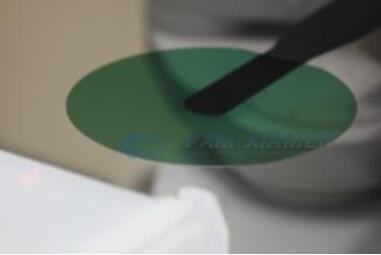SiC material has high displacement threshold energy and wide band gap, which enables the detector to work under high temperature and high radiation field. It can be applied to neutron fluence/energy spectrum measurement in strong radiation field, neutron fluence/energy spectrum measurement in high temperature environment, reactor power monitoring, radiation monitoring of spent fuel storage sites, D-T neutron tube beam current monitoring, pulsed neutron. The detector fabricated on SiC epitaxial thin film can also be used in the fields of uranium mine logging, nuclear medicine and neutron photography, in the field of charged particle and neutron measurement under high temperature and high radiation environment in space, and can be used as a vertex and track detector for high-energy physics experiments. Therein, PAM-XIAMEN can supply SiC epitaxial structure to manufacture thin SiC epitaxial detector for measurement heavy ions and charged particles. More details on the SiC epitaxial wafer, please check out the following:

1. Specification of SiC Epitaxial Thin Film
4H-SiC substrate:
Type: n type/N doped
Orientation: 4deg.off
Diameter: Ø4” (±0.1mm)
Thickness: 350(±25) µm
Doping: N-type
MPD <=1/cm3
Surface: both sides polished
Si face epi-polished, Ra<0.5nm
C-face polished, Ra<3.0nm
Primary flat: (10-10) ±0.5°
Secondary flat: necessary flat to be provided for surface identification
Laser mark: c-face
Useable area: >/= 90%
<SiC epi>
Method: CVD
Thickness: 20um+/-5%um, n type
Dopant: N atom 1E15cm-3+/-25%
Remarks:
The low-resistivity SiC substrates will be removed by HF anodic dissolution. For this reasons the resistivity of epitaxial SiC layer should be as high as possible and resistivity of SiC substrate should be as low as possible.
So, to deal with this problem, we will try to choose lower resistivity substrate around 0.02 ohm.cm, and epi layer in low concentration to higher the resistivity around 13 ohm.cm during the epitaxial growth of silicon carbide.
2. Requirements of High-Performance Detector for Epitaxial Growth of SiC Thin Films
To make high performance detector, the quality of SiC single crystalline epitaxial thin film growth should meet following requirements:
1) Few defects and good uniformity of SiC substrate and epitaxial layer;
2) Smaller reverse leakage current and higher reverse bias voltage;
3) Larger thickness of the detector sensitive area;
4) A low density of surface states on SiC.
3. Requirements for Metal Electrodes of Detectors on SiC Epitaxial Thin Film
The requirements of SiC detectors for metal electrodes are mainly:
Ohmic contact: Low specific contact resistivity and high stability;
Schottky contact: There is a large Schottky barrier height, and the barrier distribution is uniform.
3.1 Ohmic Contact
For n-type 4H-SiC semiconductor material, to form ohmic contact, the electrode material needs to be a metal with low work function that satisfies the condition of Φm<Φs, while 4H-SiC has a large forbidden band width (3.26eV), and the electron affinity is only 3.1eV, and the work function of most metals is 5-6 eV, it is difficult to find low work function metals that meet the conditions, and the metal/SiC contact generally exhibits rectification characteristics.
The current method for preparing n-type SiC ohmic contact is to use metal and heavily doped (>1*1018 cm-3) SiC contact to anneal at high temperature (>950 °C). The formation of interfacial silicide at high temperature can overcome the influence of SiC epitaxial thin film surface properties on contact properties.
3.2 Schottky Contact
Schottky contacts are fabricated by depositing metal on a SiC epitaxial layer. A good Schottky contact requires a large Schottky barrier height. For n-type SiC epitaxial thin film process, Schottky contacts require lower doping concentrations, typically lightly doped (<1015).
4. FAQ of SiC Epitaxial Thin Film
Q1: We would like to know the metal contamination level and the elements inside of the SiC epitaxial thin film wafer we bought below. If possible, could you provide it?
PAMP19056-SIC
Substrate
Poly Type: 4H-SiC, 4”size
Dopant: N atom, E17-E18cm-3
SiC epi
Method: CVD
Thickness: 10um
Dopant: N atom 1E16cm-3
A: Please see attached table below.
Contact our sales team: victorchan@powerwaywafer.com for complete data of the metal contamination level and the elements of SiC epitaxial wafer.
| Element | E10Atoms/cm2 |
| Na | – |
| Mg | 0.03 |
| Al | – |
| K | – |
| Ca | – |
| Ti | – |
| V | – |
| Cr | 0.00 |
| Mn | – |
| Fe | – |
| Co | – |
| Ni | – |
| Cu | – |
| Zn | – |
| Mo | – |
| W | – |
| Pb | 0.01 |
Q2: Could you let me confirm if the metal element data was measured on the SiC wafer surface or inside?
A: The data of the metal contamination level and the elements was measured inside of SiC epitaxy.
Q3: According to your data, the measurement method for determining the metal contamination level and the elements on SiC epitaxial thin film wafer is ICP-MS, isn’t it. Does “inside” mean that the measurement was done by the dissolution of the surface to a specific depth? Is this understanding correct?
A: Yes, we use ICP-MS to measure the metal contamination level and the elements on SiC epi wafer, and it’s done by dissolute the surface to a specific depth inside the SiC wafer.
For more information, please contact us email at victorchan@powerwaywafer.com and powerwaymaterial@gmail.com.

